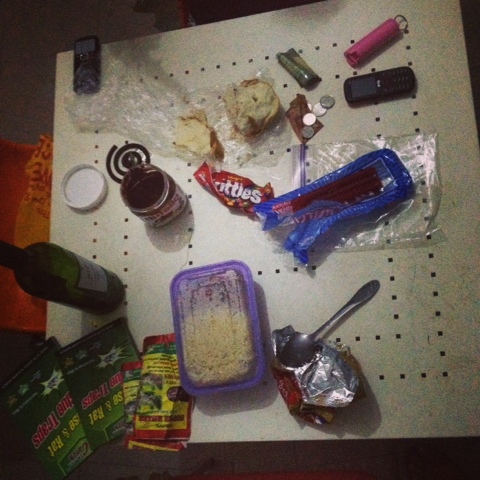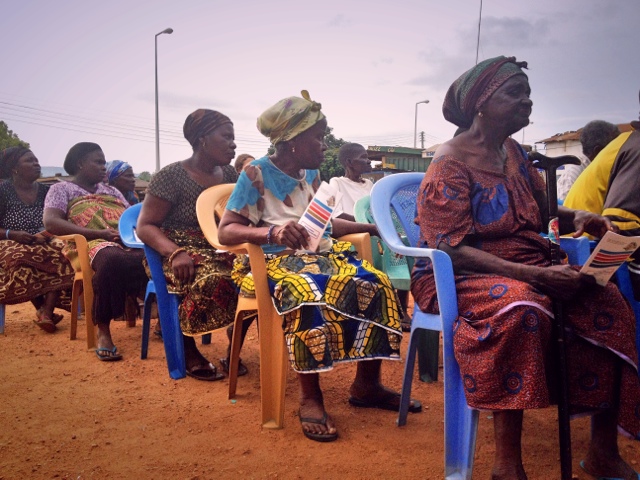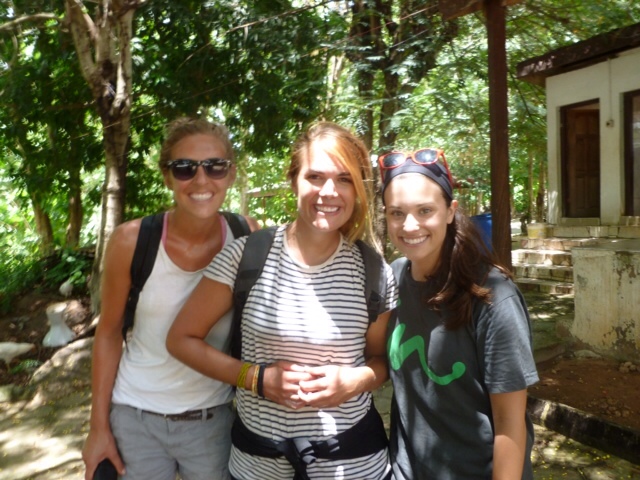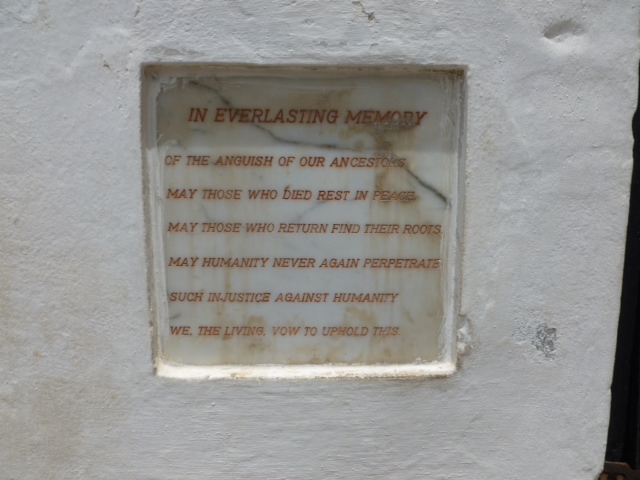7:30 AM: I arrive on foot at Sweet Mother, a reputable food stall in Kasoa, to purchase lunch for the staff of the day. The one time I had been given lunch during a workday I was served rice, stew, and a hard boiled egg. I ordered six of these. "Eggs are finished" I was told. Chicken was the next least questionable option. "No no," said the woman (Sweet Mother?) "Chicken is finished." At 7:30 in the morning? Okay. "Cow meat!" she says, swirling a chunky vat of steaming brown. "Or fish." I glanced at the pile of dried fish stinking in a pile on the counter and dry heaved a little. The Ghanaian Hep B staff might have enjoyed cow meat or fish, but I was the one who had to sit with the smelly food in a taxi in traffic. I ordered rice, stew, and beans and hoped it would be an acceptable Ghanaian lunch.
8:15: Arrive at Nyanyano DA Government School with Claire, who started the project with me, and two new volunteers from our NGO who we have appointed to take over our project duties when we leave Ghana.
We greeted the headmaster and waited for our team to arrive. Mr. Tahir is the administrator of Justab Private Hospital and head of Alpha Al-Akeem, the organization that we are collaborating with to provide discounted screening services and vaccines. Tahir was to bring two nurses and a lab technician with him that day.
From the moment we set foot on the campus, we were swarmed with children. Teachers made minimal efforts to hold them back. We could barely walk to the headmaster's office through the crowd of jumping and screaming boys and girls. I felt like Beyonce.
8:25: Receive a phone call from Tahir saying that he is at the Station, just down the road from the school and will be there in a moment.
8:30: The program is set to start.
8:40: Call Tahir. Learn that the car his staff was traveling in had gotten stuck in mud. He had left to go rescue them.
9:00: Waiting.
9:10: Parents arrive for the optional pre-program parent education session
9:30: Waiting.
9:40: Panic. I confess angrily to Claire my frustration. She and I had been working day and night to execute this project. We raised over $3200 in one month. It felt like people didn't respect our efforts enough to be there on time. Rationally I knew the mud situation was completely unprecedented, but this wasn't the first time we had been left hanging like this and the feeling of disappointment in the moment was all too familiar.
9:40: Tahir arrives! We usher him into the classroom where parents have gathered. Tahir speaks in a combination of Twi and Fanti, two of the local dialects. We Obrunis sit cramped into the small old-fashioned desks and watch as he animatedly speaks then answers questions.
I was thrilled that 10-15 parents had showed up. Based on what I have seen of the family dynamic and importance of work in Ghana, I had doubted any parents would give up work time to come to school to be educated about their child's health. The talk ended and the parents all rose to shake each of the Obrunis' hands, thanking us profusely. We thanked them for coming and began to set up the classroom, children crowded five deep around the doors and windows to watch us.
The screening began. We led in groups of ten children from class 4A. One at a time, they went to the front of the room and had a sample of blood drawn by the male nurse Atoo. Claire gave them all pep talks beforehand, warning them that the needle might pinch for a moment but that they had to be strong! The little boys were troopers, holding the cotton balls on their veins and flexing to proudly as they were led to another section of desks to wait for their results. A few girls cried, and we tried to go sit next to them and hold their hands if they looked nervous walking up to the nurse drawing the blood.
I was thrilled that 10-15 parents had showed up. Based on what I have seen of the family dynamic and importance of work in Ghana, I had doubted any parents would give up work time to come to school to be educated about their child's health. The talk ended and the parents all rose to shake each of the Obrunis' hands, thanking us profusely. We thanked them for coming and began to set up the classroom, children crowded five deep around the doors and windows to watch us.
The screening began. We led in groups of ten children from class 4A. One at a time, they went to the front of the room and had a sample of blood drawn by the male nurse Atoo. Claire gave them all pep talks beforehand, warning them that the needle might pinch for a moment but that they had to be strong! The little boys were troopers, holding the cotton balls on their veins and flexing to proudly as they were led to another section of desks to wait for their results. A few girls cried, and we tried to go sit next to them and hold their hands if they looked nervous walking up to the nurse drawing the blood.
(Photo credit Claire Boone)
The lab technician Nuzrat added the blood sample to a buffer and received results within a few minutes. We expected nearly all of the children to test negatively. The vaccine would be administered right there by the other male nurse King to the children with negative results.
Unexpectedly, the second sample taken was reactive with the buffer solution, indicating a positive Hepatitis B screen. So was the fifth. By the time we had screened 25 children, we had five positive samples.
We continued with the pattern of taking ten children at a time, but our efforts to keep order were futile. There was not much technical work for the Obrunis to do so we focused on herding the children outside away from the screening classroom.
Because of our limited funding we were only going to work with children in grade 4 that day. Our goal is to continue fundraising and promoting the project so that we can provide screening and vaccines for grades 5 and 6, and possibly the whole school some day.
The day wore on, and around 2:00 the team broke for lunch. As I led Tahir, the nurses, and the lab tech to to the headmasters' office where the food from Sweet Mother was, I explained that I wasn't sure if they ate meat so I hoped rice and beans was an OK lunch. They didn't respond. I kept watch on the classroom while they ate. Afterwards, I asked if the food had been okay. I don't think they were impressed, and they made no effort to counter my assumption. Ouch.
After the food fail, we carried on for another few hours. By the end of it all, we had obtained the following results:
99 students screened
2 teachers screened
25 students absent
1 student opted out
91 vaccines administered
8 students tested positive
8 out of 99 our our sample group tested positive.Tahir was almost beside himself, he was so upset about the results. He had expected maybe one or two children to test positive. Eight, he said, was much too high. Especially for children. Our sample was almost precisely representative of Ghana's HBV morbidity rate of 8%.
The next step is to have a laboratory test the viral load of the positive samples. This test will tell how far the virus has progressed. If the viral load is within a certain limit in the acute stage, there is a chance the virus can be cleared from the body. But if the viral load is too high, then it has progressed too far to be cured and treatment will focus on symptom management and prevention of disease progression.
The day wore on, and around 2:00 the team broke for lunch. As I led Tahir, the nurses, and the lab tech to to the headmasters' office where the food from Sweet Mother was, I explained that I wasn't sure if they ate meat so I hoped rice and beans was an OK lunch. They didn't respond. I kept watch on the classroom while they ate. Afterwards, I asked if the food had been okay. I don't think they were impressed, and they made no effort to counter my assumption. Ouch.
After the food fail, we carried on for another few hours. By the end of it all, we had obtained the following results:
99 students screened
2 teachers screened
25 students absent
1 student opted out
91 vaccines administered
8 students tested positive
8 out of 99 our our sample group tested positive.Tahir was almost beside himself, he was so upset about the results. He had expected maybe one or two children to test positive. Eight, he said, was much too high. Especially for children. Our sample was almost precisely representative of Ghana's HBV morbidity rate of 8%.
The next step is to have a laboratory test the viral load of the positive samples. This test will tell how far the virus has progressed. If the viral load is within a certain limit in the acute stage, there is a chance the virus can be cleared from the body. But if the viral load is too high, then it has progressed too far to be cured and treatment will focus on symptom management and prevention of disease progression.
(Photo credit Claire Boone)
Of course, the parents of the positive children must be informed of the results. We scheduled a date next week for Tahir and Claire to meet the teachers and parents. On that date they will also screen and vaccinate the children who were absent on Thursday.
Leaving Ghana will be bittersweet, but I will continue to work on this project from the States. I fly back to the US on Tuesday already, after spending 9 weeks in this country! I am excited to continue to move forward with this project though.
Each vaccine requires three injections, so the follow-up for the group given vaccines on Thursday will be in one month. The third booster injection will be administered in September. As I mentioned before, we already have two volunteers who recently arrived in Ghana and will be here through August. They will take over the project when Claire and I leave (Claire is gone two weeks after me), and they will hand it off to incoming Public Health volunteers as they arrive. Claire and I will type up guidelines with all of the details the successors need to know, and we will continue to manage the project remotely.
(Photo credit Claire Boone)
I'm not sure what I expected out of this volunteer opportunity. I think I envisioned myself doing background busywork for an already-established project. I never thought I would be designing and co-managing two screening projects (our tuberculosis screening was held two weeks ago, see previous blog posts). I am eternally grateful for being matched with Claire, a powerhouse of determination with the organization skills required to execute all that we did. I could not have asked for a more perfect partner-in-crime.
I had admittedly set the bar relatively average - not high, but not low - for the amount of a difference I could actually make during my internship. But our collaboration blew up the bar. I am really proud of what we accomplished and learned not to underestimate what I can accomplish by ignoring that silly bar and demanding results instead of hoping for them.
I'm not sure what I expected out of this volunteer opportunity. I think I envisioned myself doing background busywork for an already-established project. I never thought I would be designing and co-managing two screening projects (our tuberculosis screening was held two weeks ago, see previous blog posts). I am eternally grateful for being matched with Claire, a powerhouse of determination with the organization skills required to execute all that we did. I could not have asked for a more perfect partner-in-crime.
I had admittedly set the bar relatively average - not high, but not low - for the amount of a difference I could actually make during my internship. But our collaboration blew up the bar. I am really proud of what we accomplished and learned not to underestimate what I can accomplish by ignoring that silly bar and demanding results instead of hoping for them.












































